Kawasaki KLX250 S 2013, KLX 250 S 2014 Owner's manual
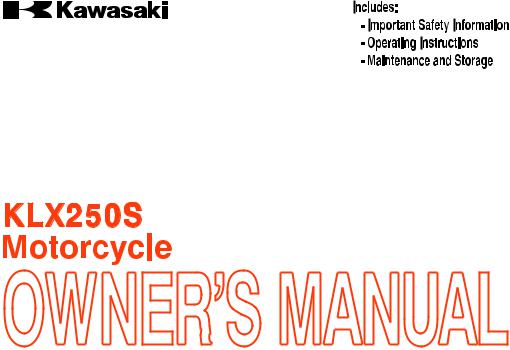
Quick Reference Guide
This Quick Reference Guide will assist you in finding the information you’re looking for.
GENERAL INFORMATION |
j |
|
|
HOW TO RIDE THE MOTORCYCLE |
j |
|
|
SAFE OPERATION |
j |
|
|
MAINTENANCE AND ADJUSTMENT |
j |
|
|
STORAGE |
j |
|
|
TROUBLESHOOTING GUIDE |
j |
A Table of Contents is included after the Foreword.
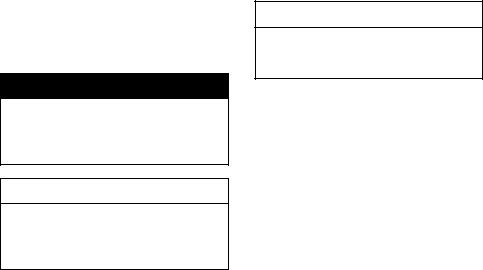
Whenever you see the symbols shown below, heed their instructions! Always follow safe operating and maintenance practices.
 DANGER
DANGER
DANGER indicates a hazardous situation which, if not avoided, will result in death or serious injury.
 WARNING
WARNING
WARNING indicates a hazardous situation which, if not avoided, could result in death or serious injury.
NOTICE
NOTICE is used to address practices not related to personal injury.
NOTE
○NOTE indicates information that may help or guide you in the operation or service of the vehicle.

 WARNING
WARNING
Engine exhaust, some of its constituents, and certain vehicle components contain or emit chemicals known to the State of California to cause cancer and birth defects or other reproductive harm.
NOTICE
THIS PRODUCT HAS BEEN MANUFACTURED FOR USE IN A REASONABLE AND PRUDENT MANNER BY A QUALIFIED OPERATOR AND AS A VEHICLE ONLY.
FOREWORD
Congratulations on your purchase of a new Kawasaki motorcycle. Your new motorcycle is the product of Kawasaki’s advanced engineering, exhaustive testing, and continuous striving for superior reliability, safety and performance.
Please read this Owner’s Manual carefully before riding so that you will be thoroughly familiar with the proper operation of your motorcycle’s controls, its features, capabilities, and limitations. This manual offers many safe riding tips, but its purpose is not to provide instruction in all the techniques and skills required to ride a motorcycle safely. Kawasaki strongly recommends that all operators of this vehicle enroll in a motorcycle rider training program to attain awareness of the mental and physical requirements necessary for safe motorcycle operation.
To ensure a long, trouble-free life for your motorcycle, give it the proper care and maintenance described in this manual. For those who would like more detailed information on their Kawasaki Motorcycle, a Service Manual is available for purchase from any authorized Kawasaki motorcycle dealer. The Service Manual contains detailed disassembly and maintenance information. Those who plan to do their own work should, of course, be competent mechanics and possess the special tools described in the Service Manual.
Keep this Owner’s Manual aboard your motorcycle at all times so that you can refer to it whenever you need information.
This manual should be considered a permanent part of the motorcycle and should remain with the motorcycle when it is sold.
All rights reserved. No part of this publication may be reproduced without our prior written permission.
This publication includes the latest information available at the time of printing. However, there may be minor differences between the actual product and illustrations and text in this manual.
All products are subject to change without prior notice or obligation.
KAWASAKI HEAVY INDUSTRIES, LTD.
Motorcycle & Engine Company
© 2013 Kawasaki Heavy Industries, Ltd. |
Mar. 15, 2013. (1) |

TABLE OF CONTENTS
SPECIFICATIONS............................... |
9 |
SERIAL NUMBER LOCATIONS......... |
13 |
LOCATION OF PARTS ....................... |
14 |
LOCATION OF LABELS..................... |
17 |
LOADING INFORMATION.................. |
21 |
GENERAL INFORMATION................. |
24 |
Meter Instruments ............................ |
24 |
Meter Instruments:........................ |
25 |
Tachometer:.................................. |
25 |
Speedometer : .............................. |
25 |
Odometer/Trip Meter AB:.............. |
26 |
Warning/Indicator Light:................ |
30 |
Keys ................................................. |
31 |
Ignition Switch/Steering Lock........... |
32 |
Right Handlebar Switches................ |
34 |
Engine Stop Switch: ..................... |
34 |
Starter Button: .............................. |
34 |
Left Handlebar Switches .................. |
35 |
Dimmer Switch: ............................ |
35 |
Turn Signal Switch:....................... |
35 |
Horn Button: ................................. |
35 |
Fuel Tank Cap.................................. |
36 |
Fuel Tank ......................................... |
37 |
Fuel Requirement: ........................ |
38 |
Fuel Tap ........................................... |
41 |
Stand................................................ |
42 |
Helmet Hook .................................... |
43 |
Tool Kit Bag/Tool Kit ......................... |
44 |
Seat.................................................. |
45 |
Rear View Mirror .............................. |
46 |
BREAK-IN........................................... |
47 |
HOW TO RIDE THE MOTORCYCLE . 49 |
|
Starting the Engine .......................... |
49 |
Jump Starting................................... |
52 |
Moving Off........................................ |
55 |
Shifting Gears .................................. |
56 |
Braking............................................. |
58 |
Stopping the Engine......................... |
59 |
Stopping the Motorcycle in an |
|
Emergency ................................... |
60 |
Parking............................................. |
61 |
Catalytic Converter........................... |
63 |
SAFE OPERATION............................. |
65 |
Safe Riding Technique ..................... |
65 |
Daily Checks .................................... |
68 |
Additional Considerations for Off |
|
Road Operation ............................ |
71 |
Additional Considerations for High |
|
Speed Operation .......................... |
72 |
MAINTENANCE AND ADJUSTMENT |
74 |
Periodic Maintenance Chart............. |
79 |
Engine Oil ........................................ |
91 |
Cooling System ................................ |
97 |
Spark Plugs...................................... |
102 |
Kawasaki Clean Air System ............. |
103 |
Evaporative Emission Control |
|
System (California model only)..... |
104 |
Valve Clearance ............................... |
105 |
Air Cleaner ....................................... |
106 |
Throttle Grip ..................................... |
111 |
Carburetors ...................................... |
114 |
Clutch............................................... |
116 |
Drive Chain ...................................... |
119 |
Brakes .............................................. |
125 |
Brake Light Switches........................ |
129 |
Front Fork......................................... |
131 |
Rear Shock Absorber....................... |
133 |
Wheels ............................................. |
136 |
Battery.............................................. |
140 |
Headlight Beam................................ |
146 |
Fuses ............................................... |
148 |
General Lubrication.......................... |
150 |
Cleaning Your Motorcycle ................ |
151 |
Bolt and Nut Tightening.................... |
157 |
STORAGE........................................... |
159 |
TROUBLESHOOTING GUIDE............ |
162 |
YOUR WARRANTY/OWNER |
|
SATISFACTION .............................. |
163 |
REPORTING SAFETY DEFECTS ...... |
169 |
ENVIRONMENTAL PROTECTION..... |
170 |
MAINTENANCE RECORD ................. |
171 |
LABEL INFORMATION ...................... |
176 |
SPECIFICATIONS 9
|
SPECIFICATIONS |
|
PERFORMANCE |
|
|
|
|
|
Minimum Turning Radius |
2.4 m (94.5 in.) |
|
DIMENSIONS |
|
|
Overall Length |
2 200 mm (86.62 in.) |
|
Overall Width |
820 mm (32.28 in.) |
|
Overall Height |
1 205 mm (47.44 in.) |
|
Wheelbase |
1 430 mm (56.30 in.) |
|
Road Clearance |
285 mm (11.22 in.) |
|
Curb Mass |
135 kg (298 lb) |
|
|
(CAL) 136 kg (300 lb) |
|
ENGINE |
|
|
Type |
DOHC, single-cylinder, 4-stroke, liquid-cooled |
|
Displacement |
249 cm³ (15.2 cu in.) |
|
Bore x Stroke |
72.0 × 61.2 mm (2.83 × 2.41 in.) |
|
Compression Ratio |
11.0 : 1 |
|
10 SPECIFICATIONS |
|
Starting System |
Electric starter |
Carburetors |
KEIHIN CVK34 |
Ignition System |
CDI |
Ignition Timing |
10° BTDC @1 300 r/min (rpm) 25° BTDC @5 000 |
(Electronically advanced) |
r/min (rpm) |
Spark Plugs |
NGK CR8E |
Lubrication System |
Forced lubrication (wet sump) |
Engine Oil |
|
Type: |
API SG, SH, SJ, SL or SM with JASO MA, MA1 or MA2 |
Viscosity: |
SAE 10W-40 |
Capacity: |
1.3 L (1.4 US qt) |
Coolant Capacity |
1.3 L (1.4 US qt) |
TRANSMISSION |
|
Transmission Type |
6-speed, constant mesh, return shift |
Clutch Type |
Wet, multi disc |
Driving System |
Chain drive |
Primary Reduction Ratio |
2.800 (84/30) |
SPECIFICATIONS 11
Final Reduction Ratio |
3.000 |
(42/14) |
Overall Drive Ratio |
8.000 |
(Top gear) |
Gear Ratio |
|
|
1st |
3.000 (30/10) |
|
2nd |
2.000 |
(30/15) |
3rd |
1.500 |
(27/18) |
4th |
1.250 |
(25/20) |
5th |
1.050 |
(21/20) |
6th |
0.952 |
(20/21) |
FRAME |
|
|
Castor |
26.5° |
|
Trail |
105 mm (3.31 in.) |
|
Tire Size: |
|
|
Front |
3.00-21 51P |
|
Rear |
4.60-18 63P |
|
12 SPECIFICATIONS |
|
|
Rim Size: |
|
|
Front |
21 × 1.60 |
|
Rear |
18 |
× 2.15 |
Fuel Tank Capacity |
7.7 L (2.04 US gal) |
|
ELECTRICAL EQUIPMENT |
|
|
Battery |
12 |
V 6 Ah |
Headlight |
12 |
V 60/55 W |
Tail/Brake Light |
12 |
V 5/21 W |
(CAL) California model
Specifications are subject to change without notice.
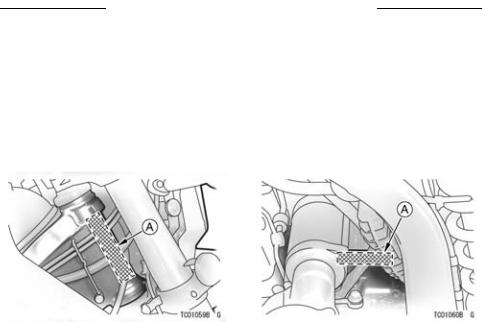
SERIAL NUMBER LOCATIONS 13
SERIAL NUMBER LOCATIONS
The engine and frame serial numbers are used to register the motorcycle. They are the only means of identifying your particular machine from others of the same model type. These serial numbers may be needed by your dealer when ordering parts. In the event of theft, the investigating authorities will require both numbers as well as the model type and any peculiar features of your machine that can help them identify it.
Frame No. |
|
Engine No. |
|
|
|
|
|
|
A. Frame Number |
A. Engine Number |

14 LOCATION OF PARTS
LOCATION OF PARTS
1. |
Clutch Lever |
5. |
Left Handlebar Switches |
2. |
Meter Instruments |
6. |
Ignition Switch/Steering Lock |
3. |
Brake Fluid Reservoir (Front) |
7. |
Right Handlebar Switches |
4. |
Front Brake Lever |
8. |
Throttle Grip |

LOCATION OF PARTS 15
9. |
Front Fork |
16. |
Rear Shock Absorber |
23. |
Horn |
10. |
Headlight |
17. |
Tool Kit Bag |
24. |
Shift Pedal |
11. |
Turn Signal Light |
18. |
Tool Kit |
25. |
Side Stand |
12. |
Fuel Tank Cap |
19. |
Helmet Hook |
26. |
Side Stand Switch |
13. |
Fuel Tank |
20. |
Brake Disc |
27. |
Drive Chain |
14. |
Choke Knob |
21. |
Brake Caliper |
28. |
Coolant Reserve Tank |
15. |
Fuel Tap |
22. |
Radiator |
29. |
Battery |
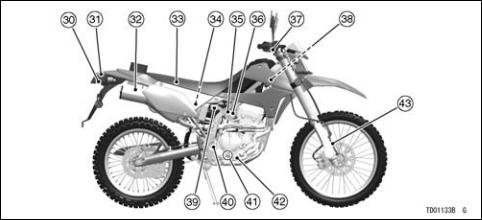
16 LOCATION OF PARTS
30. |
License Plate Light |
36. |
Idle Adjusting Screw |
40. |
Rear Brake Light |
31. |
Tail/Brake Light |
37. |
Front Brake Light |
41. |
Switch |
32. |
Muffler |
38. |
Switch |
Oil Level Inspection |
|
33. |
Seat |
Radiator Cap |
42. |
Window |
|
34. |
Air Cleaner Element |
39. |
Brake Fluid Reservoir |
Rear Brake Pedal |
|
35. |
Carburetor |
|
(Rear) |
43. |
Speedometer Lead |
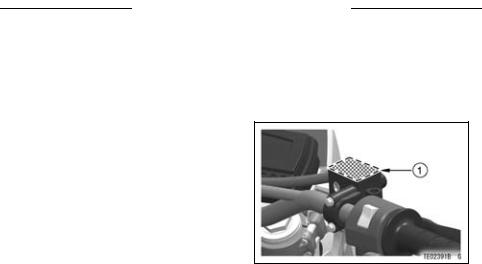
LOCATION OF LABELS 17
LOCATION OF LABELS
All warning labels which are on your vehicle are repeated here. Read labels on your vehicle and understand them thoroughly. They contain information which is important for your safety and the safety of anyone else who may operate your vehicle. Therefore, it is very important that all warning labels be on your vehicle in the locations shown. If any label is missing, damaged, or worn, get a replacement from your Kawasaki dealer and install it in the correct position.
NOTE
○The sample warning labels in this section have part numbers to help
you and your dealer obtain the correct replacement.
○Refer to the actual vehicle label for model specific data grayed out in the illustration.
1. Brake Fluid (Front)
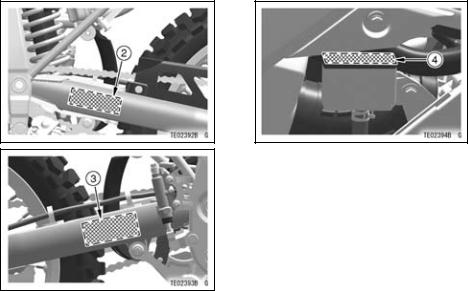
18 LOCATION OF LABELS
2. Important Drive Chain Information
3. Tire and Load Data
4. Brake Fluid (Rear)
(For further information of label, refer to the “LABEL INFORMATION” chapter.)
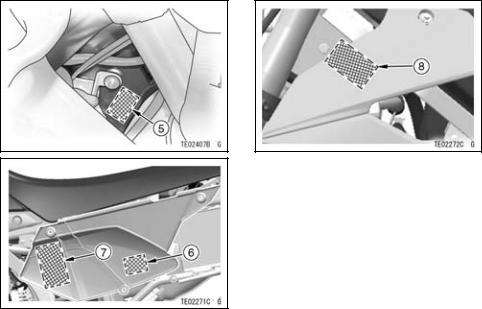
LOCATION OF LABELS 19
5.Weight and Manufacture
6.Vehicle Emission Control Information *7. Vacuum Hose Routing Diagram
8.Noise Emission Control Information
(For further information of label, refer to the “LABEL INFORMATION” chapter.)
*: Only on California model

20 LOCATION OF LABELS
*9. Fuel Level
10. Battery Poison/Danger
11. Radiator Cap Danger
(For further information of label, refer to the “LABEL INFORMATION” chapter.)
*: Only on California model
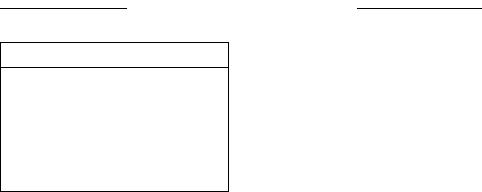
LOADING INFORMATION 21
LOADING INFORMATION
 WARNING
WARNING
Incorrect loading, improper installation or use of accessories, or modification of your motorcycle may result in an unsafe riding condition. Before you ride the motorcycle, make sure it is not overloaded and that you have followed these instructions.
With the exception of genuine Kawasaki Parts and Accessories, Kawasaki has no control over the design or application of accessories. In some cases, improper installation or use of accessories, or motorcycle modification, will void the motorcycle warranty. In selecting and using accessories, and in loading the motorcycle,
you are personally responsible for your own safety and the safety of other persons involved.
NOTE
○Kawasaki Parts and Accessories have been specially designed for use on Kawasaki motorcycles. We strongly recommend that all parts and accessories you add to your motorcycle be genuine Kawasaki components.
Because a motorcycle is sensitive to changes in weight and aerodynamic forces, you must take extreme care in carrying cargo, passengers and/or in the fitting of additional accessories. The following general guidelines have
22 LOADING INFORMATION
been prepared to assist you in making your determinations.
1.Any passenger should be thoroughly familiar with motorcycle operation. The passenger can affect control of the motorcycle by improper positioning during cornering and sudden movements. It is important that the passenger sit still while the motorcycle is in motion and not interfere with the operation of the motorcycle. Do not carry animals on your motorcycle.
2.You should instruct any passenger before riding to keep his feet on the passenger footpegs and hold on to the operator or seat strap. Do not carry a passenger unless he or she is tall enough to reach the footpegs and footpegs are provided.
3.All baggage should be carried as low as possible to reduce the effect
on the motorcycle center of gravity. Baggage weight should also be distributed equally on both sides of the motorcycle. Avoid carrying baggage that extends beyond the rear of the motorcycle.
4.Baggage should be securely attached. Make sure that the baggage will not move around while you are riding. Recheck baggage security as often as possible (not while the motorcycle is in motion) and adjust as necessary.
5.Do not carry heavy or bulky items on a luggage rack. They are designed for light items, and overloading can affect handling due to changes in weight distribution and aerodynamic forces.
6.Do not install accessories or carry baggage that impairs the performance of the motorcycle. Make sure that you have not adversely

affected any lighting components, road clearance, banking capability (i.e., lean angle), control operation, wheel travel, front fork movement, or any other aspect of the motorcycle’s operation.
7.Weight attached to the handlebar or front fork will increase the mass of the steering assembly and can result in an unsafe riding condition.
8.Fairings, windshields, backrests, and other large items have the capability of adversely affecting stability and handling of the motorcycle, not only because of their weight, but also due to the aerodynamic forces acting on these surfaces while the motorcycle is in operation. Poorly designed or installed items can result in an unsafe riding condition.
9.This motorcycle was not intended to be equipped with a sidecar or to
LOADING INFORMATION 23
be used to tow any trailer or other vehicle. Kawasaki does not manufacture sidecars or trailers for motorcycles and cannot predict the effects of such accessories on handling or stability, but can only warn that the effects can be adverse and that Kawasaki cannot assume responsibility for the results of such unintended use of the motorcycle. Furthermore, any adverse effects on motorcycle components caused by the use of such accessories will not be remedied under warranty.
Maximum Load
Weight of rider, passenger, baggage, and accessories must not exceed 181 kg (399 lb).
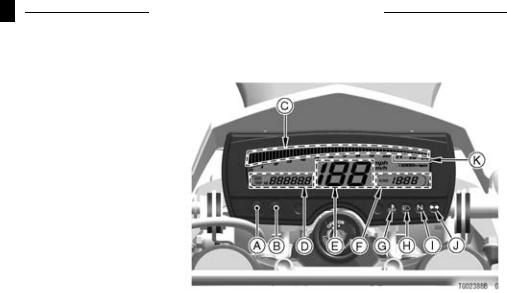
24 GENERAL INFORMATION
GENERAL INFORMATION
Meter Instruments
A.MODE Button
B.RESET Button
C.Tachometer
D.Odometer/Trip Meter AB
E.Speedometer
F.Clock
G.Coolant Temperature Warning Indicator Light
H.High Beam Indicator Light
I.Neutral Indicator Light
J.Turn Signal Indicator Light
K.Red Zone
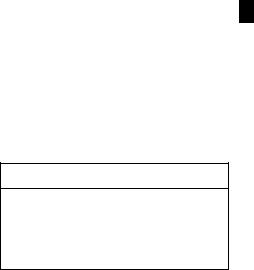
Meter Instruments:
The meter displays all segments for a few seconds when the ignition key is turned to “ON”. The tachometer momentarily goes from the minimum to the maximum, then goes back from the maximum to the minimum reading to check its operation. If any meter instruments or tachometer does not operate or display correctly, have it checked by an authorized Kawasaki dealer.
Tachometer:
The tachometer shows the engine speed in revolutions per minute (r/min, rpm). On the right side of the tachometer face is a portion called the “red zone”. Engine r/min (rpm) in the red zone is above maximum recommended engine speed and is also above the range for good performance.
GENERAL INFORMATION 25
NOTE
○This motorcycle is equipped with the engine speed limitter to prevent the excesive high engine speed. When operating this limitter, the segments of the tachometer indicate the different engine speed and stops at about 5000 r/min (rpm) for the ignition control, but this operation is not a failure.
NOTICE
Engine r/min (rpm) should not be allowed to enter the red zone; operation in the red zone will overstress the engine and may cause serious engine damage.
Speedometer :
The speedometer shows the speed of the vehicle in digital values.
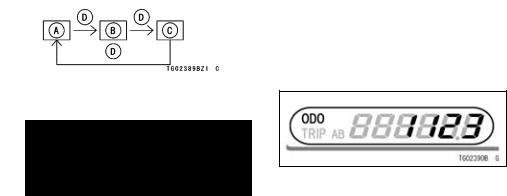
26 GENERAL INFORMATION
Odometer/Trip Meter AB:
This meter displays the odometer, the trip meter AB, and the fuel warning message.
The odometer and the trip meter AB can be shifted pushing the MODE button.
Odometer -
The odometer shows the total distance in kilometers or miles that the vehicle has been ridden. This meter cannot be reset.
A.Odometer
B.Trip meter A
C.Trip meter B
D.MODE Button
NOTE
○Do not shift the odometer/trip meter while riding for safe operation.
NOTE
○The data is maintained even if the battery is disconnected.
○When the figures come to 999999, they are stopped and locked.
Trip Meters A/B -
The trip meter shows the distance in kilometers or miles traveled since it was last reset to zero.
To reset the trip meter:

•Push the MODE button to display the trip meter A or B.
•Pushin. the RESET button and hold it
•After two second, the figure display turns to 0.0, and then starts counting when the vehicle is operated. The meter counts until it is next reset.
NOTE
○The data is maintained by the back -up power if the ignition key is turned off.
○When the trip meter reaches 999.9 (TRIP A) or 9999.9 (TRIP B) while riding, the meter resets to 0.0 and continues counting.
○When the battery is disconnected, the meter display resets to 0.0.
GENERAL INFORMATION 27
Mile/Km Display:
Mile/Km Display can alternate between English and metric modes (mph and km/h) in the meter unit. Make sure that km/h or mph according to local regulations is correctly displayed before riding.
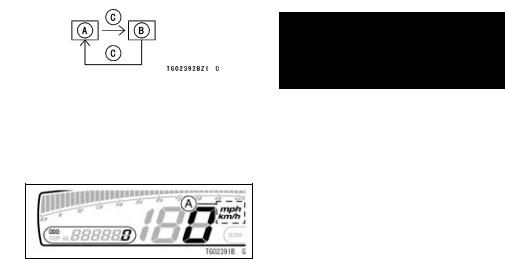
28 GENERAL INFORMATION
NOTE
○Do not operate the vehicle with the meter unit displaying in the wrong unit (km/h or mph). Shift the km/h·mph display in the meter unit as follows.
•Display the odometer.
•The km/h·mph display shifts by pushing the RESET button while the MODE button pushed in.
A. Km/h·Mph Display
•The km/h/mph display shifts as follows.
A.Km/h
B.Mph
C.Push RESET Button with MODE Button in
NOTE
○The data is maintained even if the battery is disconnected.
Clock:
To adjust hours and minutes:
•Turn the ignition key to “ON”.
•Push the RESET button for more than two seconds. Both the hour and minute displays start blinking.
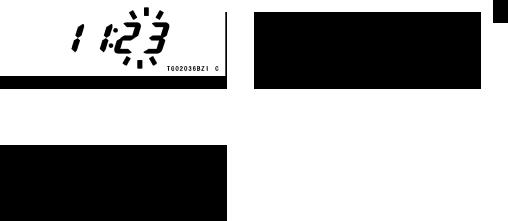
GENERAL INFORMATION 29
•Push the RESET button. The hour display only blinks. Push the MODE button to advance the hours.
•Push the RESET button. The hour display stops blinking and the minute display starts blinking. Push the MODE button to advance the minutes.
•Push the RESET button. Both the hour and minute displays start blinking again.
•Push the MODE button. The displays stop blinking and the clock starts working.
NOTE
○Pushing the MODE button momentarily advances the hour or minute step by step. Pushing and holding the button advances the hour or minute continuously.
○The clock works normally from the back-up power while the ignition switch is turned off.
